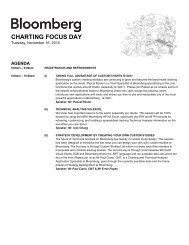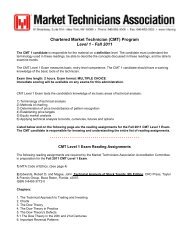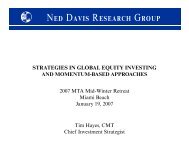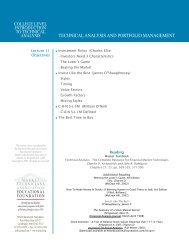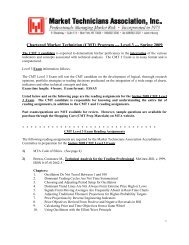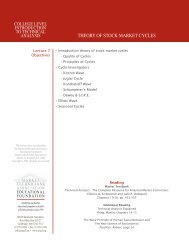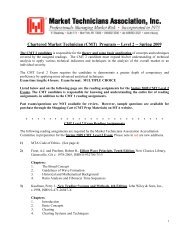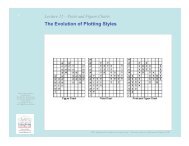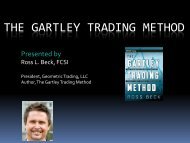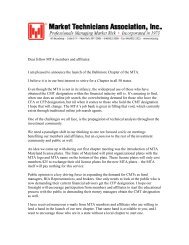Journal of Technical Analysis - Market Technicians Association
Journal of Technical Analysis - Market Technicians Association
Journal of Technical Analysis - Market Technicians Association
You also want an ePaper? Increase the reach of your titles
YUMPU automatically turns print PDFs into web optimized ePapers that Google loves.
Allocation and Average Return <strong>of</strong> Selected Style Indexes<br />
Each <strong>of</strong> the six 12,1 portfolios’ allocation (Panel A) and contribution to returns (Panel B) <strong>of</strong> the six Russell indexes are reported in Exhibit 5. For the top<br />
performing portfolio, and for all 12,1 portfolios, the largest allocation was the SV at 34.1%. This means that SV had the largest prior 12 month performance 34.1%<br />
<strong>of</strong> the time and was therefore held in the 12,1 portfolio 34.1% <strong>of</strong> the 34 year period analyzed. The SV was also the highest performing style index over the 34 year<br />
period analyzed, but was not the leading average return contributor to the 12,1 portfolio performance. The largest contributor was MG, followed by SG, LV, then SV,<br />
with average monthly returns <strong>of</strong> 2.11%, 1.97%, 1.78%, and 1.69%, respectively. This indicates that the momentum exhibited is not simply a SV phenomenon. For<br />
the bottom performing 12,1 portfolio the largest allocation was the LG at 32.8% and the smallest was the MV at 3.7% with average monthly returns <strong>of</strong> 0.11% and<br />
0.70%, respectively.<br />
Persistence Through Time <strong>of</strong> 12,1 Portfolios<br />
To succinctly show that the 34 year period results are not solely driven by a particular time period and are robust through time we report the top, bottom, and<br />
Long-Short 12,1 portfolios in Exhibit 6 (on page 54). Top is the 12,1 portfolio with the highest formation period performance, bottom is the 12,1 portfolio with the<br />
lowest formation period performance, and Long-Short is the difference. On an annualized return basis the returns for the periods analyzed vary from 3.08% to<br />
13.71%, depending on the period analyzed, and averaged 9.25%. If you exclude the two largest return periods from ’72 to ’80 the Long-Short portfolio still returns<br />
an annualized 5.08%. On an individual calendar year basis, not reported for brevity, the worst Long-Short portfolio return was -20.35% in 2000 and the best was<br />
50.11% in 1999.<br />
Average Holding Period<br />
To further evaluate the momentum persistence we analyzed the average holding periods <strong>of</strong> the top and bottom 12,1 portfolios. Even though style indexes were<br />
analyzed on a monthly basis for reshuffling, on average, reshuffling was only required about twice a year. The top and bottom positions are held for an average <strong>of</strong><br />
5.65 and 6.10 months, respectively. Interestingly, the LG had the longest holding period for both the top and bottom position. The bottom position was for 26 months<br />
from March 1976 to April 1978 and the top position was for 24 months from May 1989 to April 1991. The relatively infrequent need for rebalancing when combined<br />
with the low cost <strong>of</strong> exchange traded funds supports the viability <strong>of</strong> this momentum trading strategy.<br />
Conclusion<br />
Style index momentum is particularly interesting since it provides a diversified, low-cost trading strategy to exploit it. This inexpensive and diversified option<br />
provides the opportunity for money managers, regardless <strong>of</strong> the amount <strong>of</strong> assets under management, to include such strategy into their tactical asset allocation<br />
decisions. Such style index momentum trading strategies have outperformed on both a raw and risk-adjusted return basis, with the long minus short portfolio<br />
generating an average 9.25% annual return over the 34-year period analyzed. Although the excess returns vary, they are robust through time and after controlling for<br />
potentially confounding effects.<br />
Jo u r n a l <strong>of</strong> <strong>Technical</strong> <strong>Analysis</strong> • 2008 • Issue 65 53




